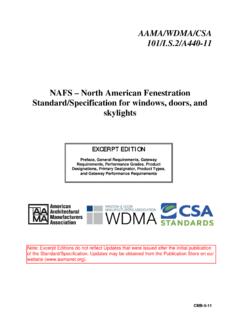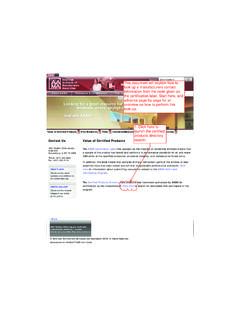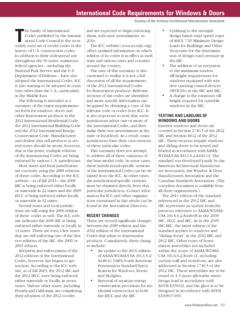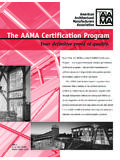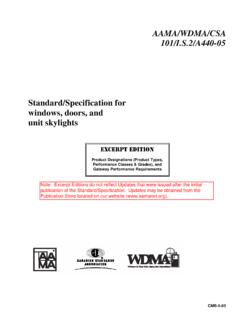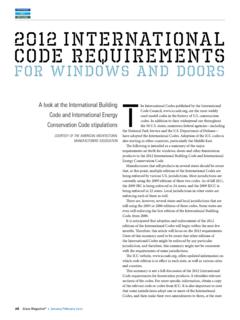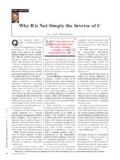Transcription of Differences in Design Pressure and Performance Grade
1 Door& to Some BasicsDifferences in Design Pressure and Performance GradeB Y K E N B R E N D E NFenestration products areundeniably becoming morecomplex as performanceexpectations diversify and same is true of the standardsthat guide those who Design andspecify these products. The lynch-pin of these standards is theAAMA/WDMA/CSA 101 , The north AmericanFenestration Standard/Specification[NAFS] for Windows, Doors andSkylights, the latest version ofwhich is 2008 although the 2011version is waiting in the wings foradoption into the 2012 is apparent widespreadmisuse of certain NAFS perform-ance terms within the industry,especially Design Pressure per-formance class and performancegrade. At times, marketplace con-fusion has led to specifying thewrong product for a given build-ing application.
2 Design PressureRecall that wind force is theprimary source of structuralloading on an installed door orwindow. Wind exerts pressuredirectly proportional to thesquare of the wind Pressure thus serves to localize a Design for the windloading expected at the installa-tion site, based on maximumexpected wind speeds per thewind speed contour map inASCE-7. Design Pressure is theanchor from which the key attrib-utes of structural strength andresistance to air and water pene-tration flow. It is a starting pointfor defining the Performance of agiven fenestration product, yet itis not a Performance rating itself. Performance Class Performance class roughlydescribes the likely target applica-tion for a door or window. Likedesign Pressure , it is not in itself aspecific Performance rating.
3 Thefour classes defined in NAFS are:R:commonly used in one- and two-family dwellings;LC: commonly used in low-rise and mid-rise multi-familydwellings and other buildings where larger sizes and higher loading requirements are expected;CW:commonly used in low-rise and mid-rise buildings where larger sizes, higher loading requirements, limits on frame member deflection and heavy use are expected; andAW: commonly used in high-rise and mid-rise buildings to meet extreme loading requirements and limits on GradeThe specific Performance levelof a fenestration product that fallswithin one or more performanceclasses is given by the performancegrade. While this is related to thedesign Pressure , that is not of itselfthe Performance level product only achieves a per-formance Grade rating if that prod-uct complies with all requirementsof the NAFS standard for a certaindesign Pressure corresponding to amaximum expected wind velocityregime at the given geographicallocation.
4 This is the link betweendesign Pressure and performancegrade but the latter goes furtherby encompassing: a) Structural Performance : TheComparison Table (IP only)PerformanceGrade( Design Pressure [psf])RLCCHCAWRLCCWAW15*--------*------2 5----------30*----*--40*50 100(5 psf increments)75 max85 max90 max100 max(no max)100 max100 max100 max(no max) 100----(no limit)---(no limit) 2010, all information on this Web page, including the content and chart, are copyright of Class OverviewComparison of AAMA/WDMA/CSA 101 and AAMA/WDMA/CSA 101 ClassGatewayRequirementsOptionalPerforma nceGradesAAMA/WDMA/CSA 101 101 on page 20 Source: AAMAC omparison Table (Inch-Pound)door& applied for structural per-formance verification is 150 per-cent of Design Pressure for doorsand windows and 200 percent forunit skylights and tubular daylightdevices. This is a test that assessesany permanent damage associatedwith the assembly;b) Water penetration resistance:The water penetration resistancetest Pressure , which simulates theforce behind wind-driven rain, isgenerally is based on 15 percent ofthe Design Pressure for R, LC, andCW Performance classes and 20percent of the Design Pressure forAW Performance classes;c) Air infiltration resistance;d)Uniform load-deflection test;e)Forced-entry resistance (ifapplicable);f) Operating force (if applicable).
5 Andg)Product type- or class-specificdurability Performance class has aleast permissible threshold per-formance Grade based on a mini-mum Design Pressure for thestructural capacity, air infiltrationresistance or water penetrationresistance that a product musthave for it to qualify for that lowest level is known as theentry level or gateway perform-ance requirement. Gateway per-formance grades for the four per-formance classes are:15 psf (720 Pa) for R class; 25 psf (1,200 Pa) for LC class; 30 psf (1,440 Pa) for CW class; and40 psf (1,920 Pa) for AW class. Note that a single product mayqualify for multiple essential takeaway fromthis abbreviated seminar is thatthere is a difference betweendesign Pressure and performancegrade. Some manufacturers haveerroneously marketed productssolely based on the Design pres-sure rating.
6 Performance grademeans that the product was testedat the applicable Design pressurefor all Performance requirementsidentified by Performance gradeand Design Pressure and the corre-sponding uniform load structuraltest pressures and water penetra-tion resistance test pressures for thefour NAFS Performance classes areindicated in the table on page higher performancegrade may be specified in each per-formance class (except AW) abovethe minimum gateway requirementin increments of 5 psf (240 Pa), up toa maximum cap of 100 psf (4,800Pa). For Classes R through CW,optional Performance classes arecapped at 60 psf (2,880 Pa) above theminimum gateway Design is no maximum performancegrade limit for AW NAFS, unit skylights arespecified as either R or CW class,with the minimum performancegrades shown. Optional perform-ance grades within these classesfor unit skylights are the same asthose for doors and windows.
7 AWand LC classifications are notavailable for unit skylights. Ken Brenden serves as technical servicesmanager for the american ArchitecturalManufacturers Association inSchaumburg, Ill. He may be reached AAMA ANALYSISCONTINUEDT here is a difference between Design Pressure and Performance Grade . Some manufacturers have erroneously marketed products solely based on the Design Pressure rating. 2011 Door & Window Manufacturer Magazine, 540/720-5584, , All rights reserved. Reprinted with permission.
